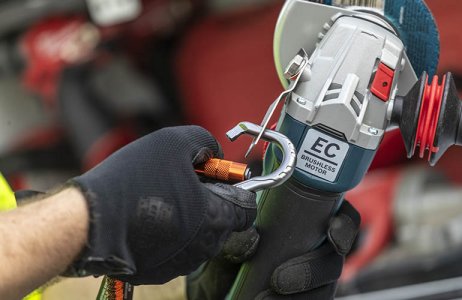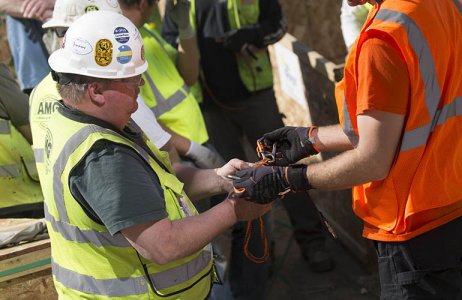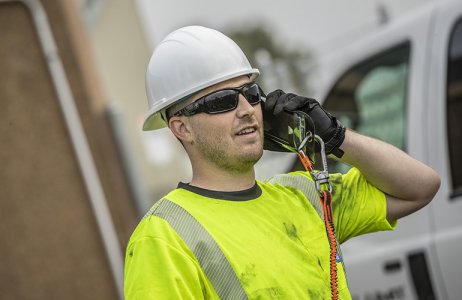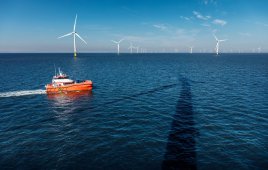Wind-turbine technicians face the challenging task of climbing a couple of hundred feet or more up-tower and safely transporting the plethora of tools required for working atop their towering workplace. This is typically done with proper tethering, ensuring tools are securely fastened to a tech’s body while climbing — or if the wind speeds or equipment weight are too great, using a winch and bucket to hoist tools up the turbine is another option.

Power and hand tools can be secured while working at heights by attaching a carabiner to a connection point on said tool. The lanyard is then anchored on a worker’s person or another stable point on the worksite.
There are three rules for technicians working at heights to remember to ensure their equipment travels securely up and downwind turbines.
Dropping objects from atop a 200-foot turbine carries plenty of risks. The greatest hazard is a possible injury to workers on the ground. A corner of the manufacturing industry has developed fall-protection products to keep tools secured, however, there has been a lack of enforceable standards for drop prevention while laborers work at heights.
In July 2018, the International Safety Equipment Association enacted the American National Standard for Dropped Object Prevention Solutions (ANSI/ISEA 121-1208), which, for the first time, created standards for manufacturing and testing equipment meant for drop prevention. The new standard is a step forward in the safety industry, but a voluntary one.
“It takes tool tethering from duct tape and rope, which most [workers] are using out there, to engineered solutions that are that are safer to use,” says Nate Bohmbach, product director at Ergodyne, a developer of safety gear for construction and industrial workers. Until now, there has been little guidance for workers on what constitutes a proper tethering system. Bohmbach points out that without a set standard, there is nothing to differentiate duct tape and string from a properly rated tool lanyard and attachment point. “The new standard formalizes tethering as a best practice,” he adds.
ANSI/ISEA 121-2018 also establishes minimum design, performance, testing, and labeling requirements for drop-prevention products.
Ergodyne backed the new safety standard, with international manufacturing company 3M. Bohmbach says it provides a rule sheet for the manufacturers designing drop-prevention products and the workers using the gear.

Loose electronics like phones and tablets can be held in pouches that zip close, and attach to carabiners through a steel ring.
“Now that we’ve led the way to develop this standard, our full attention is on helping workers understand what it means, and how it can help them,” says Bohmbach.
To this end, Ergodyne employees have authored “The Three T’s of dropped objects prevention.” The three T’s stand for trapped, tethered, and topped. They are modeled after the ABC’s of fall protection.
- Anchorage: Attaching a lifeline to a secure point.
- Body support: Wearing a body belt or harness.
- Connecting device: The device, often a lanyard, that connects body support to an anchor point.
“It’s not just dropped-object prevention, Bohmbach says. “It’s safely managing your equipment to and from the work site and while at heights, and dropped objects is a huge part of that.”
The Three T’s of safety
By Ergodyne’s definition, trapping means to secure a tool with a retrofitted attachment point meant for tethering it to an anchor. This can be done with sleeves, slips for screwdrivers, brackets and wraps or other attachments installed with tape and string.
Tethering tools with a lanyard keep them secured to an anchor using a carabiner. Ergodyne carries lanyards that come in different lengths, including a coiled model that stretches.
Equipment can also be carried up a wind turbine using a topped bucket, bag, or pouch. Ergodyne’s topped products have tethering points and covers to keep contents from spilling out if inverted.

Tethers are typically lanyards with an attached carabiner. They’re manufactured at varying lengths for different work situations.
Although dropped objects and fall risks are two different hazards, one can lead to the other. “The obvious drop risk is an object striking somebody below. That’s why you prevent dropped objects,” he explains. “But we also teach in our training that this protects workers at height as well. A dropped objects can lead to somebody trying to overexert and grab something that they’ve dropped, and it can throw them off balance and lead to a fall.”
Bohmbach compares this reaction to catching a pen that’s rolling off a desk. Now imagine accidentally losing grip on a cell phone or wrench when atop a wind turbine. A similar reaction could result in a fatality.
Technicians typically carry hand tools, power tools, and monitoring devices, such as iPads, up turbines. Each of these items need to be fastened to a technician or held inside a topped container. Any loose object is at risk of dangerously falling to the ground or inside the turbine and causing equipment damage.
“Anything that will help a climber keep his hands free and those tools tethered — basically our whole line could apply to wind power,” shares Al Buczkowski, marketing communications manager at Ergodyne. The company field tests products for about a month before bringing them to market. The drop-prevention gear is given to a trusted technician and used on a work site.
“It’s really just listening to that end-user. They’re the ones that know the problems and it’s having a direct line with them,” Bohmbach adds. “Techs are gear junkies. They know what’s good and what’s bad; they know what’s going to work and what’s not going to work; and they love actually getting their hands on new stuff and trying it out and that’s with any of our products, not just dropped object stuff.”
Filed Under: Featured, O&M, Safety



